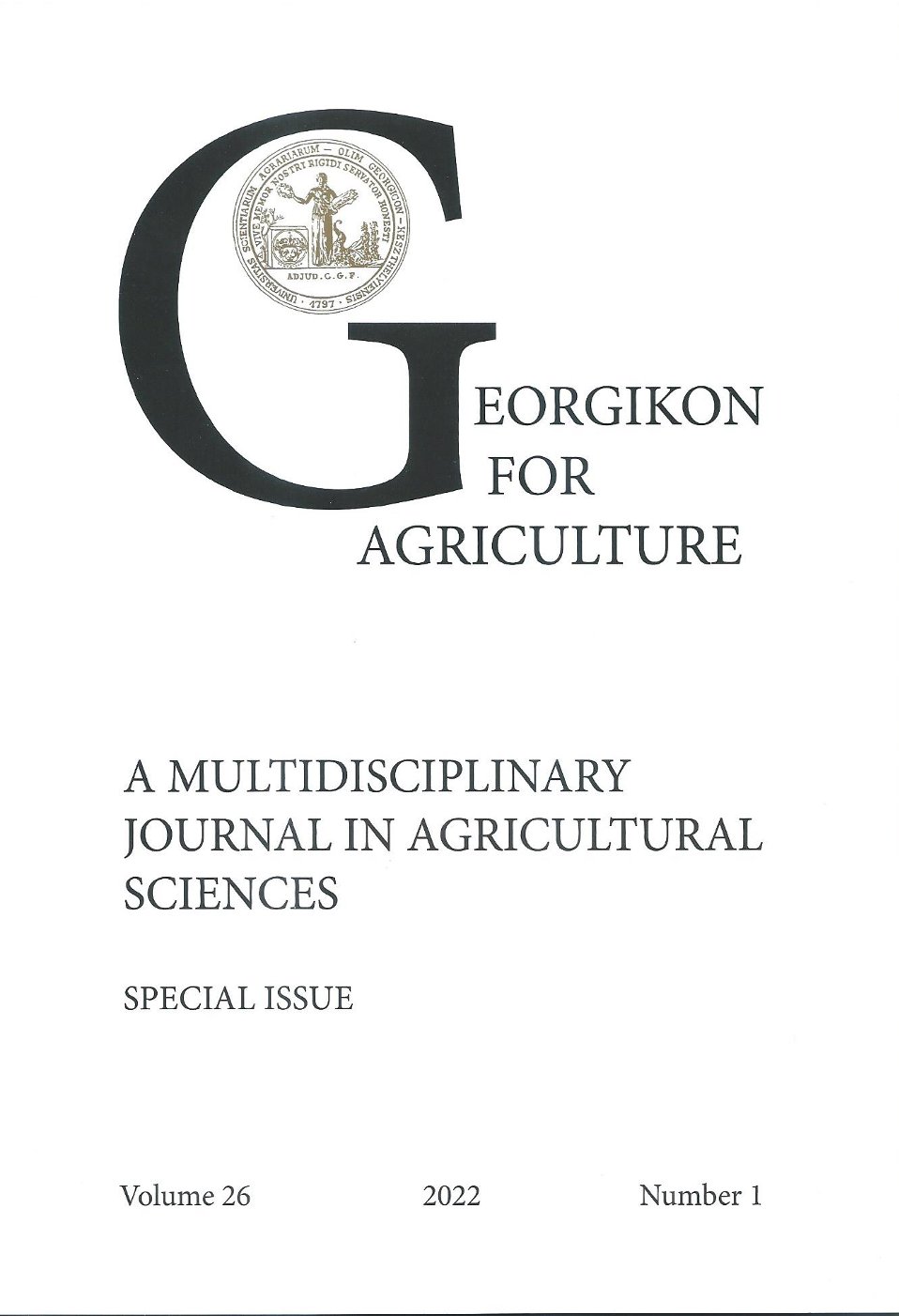A Botrytis cinerea extracelluláris fehérjehálózatának vizsgálata tömegspektrometriai, statisztikai és hálózatelméleti módszerekkel
Kulcsszavak:
Furmint, Botrytis cinerea, extracelluláris fehérjék, skálafüggetlen hálózatokAbsztrakt
Számos, egymástól igen távol eső biológiai struktúrában felfedezhetők a skálafüggetlen hálózatok. Ilyen hálózati modellel írható le a rákbetegség kialakulása, a COVID-19 járvány terjedése, néhány neurális hálózat felépítése, valamint több, már feltérképezett fehérje-fehérje interakciós hálózat. Kutatómunkánk során a botritizáció négy egymást követő fázisában lévő Furmint szőlőbogyókon laboratóriumban nevelt B. cinerea extracelluláris fehérjemintázatát hasonlítottuk össze a nemesrothadásért (aszúsodásért) felelős metabolikus folyamatok mélyebb megértéséért. Eredményeink arra utaltak, hogy a B. cinerea extracelluláris fehérjehálózatára jó közelítést ad a Barabási-Albert féle skálafüggetlen hálózati modell. Vizsgálataink során meghatároztuk az extracelluláris fehérjehálózatok olyan főbb statikus paramétereit, mint a csomópontok és interakciós kapcsolatok száma, a fokszámeloszlás, az átlagos fokszám és az átlagos klaszterezettségi együttható. Továbbá azonosítottuk a hálózat főbb komponenseit, valamint a hálózat – és így a nemesrothadás – szempontjából kulcsfontosságú fehérjéket.
Hivatkozások
Albert, R., Jeong, H. and Barabási, A-L. 2000. Error and attack tolerance of complex networks. Nature. 406. 378–382.
Albert, R. 2005. Scale-free networks in cell biology. Journal of Cell Science 118(21). 4947–4957.
Andrew, X. C. and Christopher, J. 2020. Scale-free structure of cancer networks and their vulnerability to hub-directed combination therapy. https://doi.org/10.1101/2020.07.01.159657
Barabási, A-L. 2016. Network Science. Cambridge University Press.
Bollobás, B. 1979. Graph Theory: an Introductory Course. New York, Springer Verlag
Buchanan, M. 2000. Ubiquity: The Science of History, or Why the World is Simpler Than We Think. Weidenfeld & Nicolson.
Dunne, J. A. 2006. The network structure of food webs. In: Ecological Networks: Linking Structure to Dynamics in Food Webs. 27–86.
Giot, L., Bader, J. S., Brouwer, C., Chaudhuri, A., Kuang, B., Li, Y., Hao, Y. L., Ooi, C. E.,Godwin, B., Vitols, E., Vijayadamodar, G., Pochart, P., Machineni, H., Welsh, M., Kong, Y., Zerhusen, B., Malcolm, R., Varrone, Z., Collis, A., Minto. M., Burgess. S., McDaniel. L., Stimpson, E., Spriggs, F., Williams, J., Neurath, K., Ioime, N., Agee, M., Voss, E., Furtak, K., Renzulli, R., Aanensen, N., Carrolla, S., Bickelhaupt, E., Lazovatsky, Y., DaSilva, A., Zhong, J., Stanyon, C. A., Finley, Jr. R. L., White, K. P., Braverman, M., Jarvie, T., Gold, S., Leach, M., Knight, J., Shimkets, R. A., McKenna, M. P., Chant, J. and Rothberg, J. M. 2003. A protein interaction map of Drosophila melanogaster. Science. 302. 1727-1736.
Ho, Y., Gruhler, A., Heilbut, A., Bader, G. D., Moore, L., Adams, S.-L., Millar, A., Taylor, P., Bennett, K., Boutilier, K., Yang, L., Wolting, C., Donaldson, I., Schandorff, S., Shewnarane, J., Vo, M., Taggart, J., Goudreault, M., Muskat, B., Alfarano, C., Dewar, D., Lin, Z., Michalickova, K., Willems, A. R., Sassi, H., Nielsen, P. A., Rasmussen, K. J., Andersen, J. R., Johansen, L. E., Hansen, L. H., Jespersen, H., Podtelejnikov, A., Nielsen, E., Crawford, J., Poulsen, V., Sørensen, B. D., Matthiesen, J., Hendrickson, R. C., Gleeson, F., Pawson, T., Moran, M. F., Durocher, D., Mann, M., Hogue, C. W. V., Figeys, D. and Tyers, M. 2002. Systematic identification of protein complexes in Saccharomyces cerevisiae by mass spectrometry. Nature. 415. 180–183.
Jackson, R. S. 2014. Botrytis. In: Robinson, R. K.; Batt, C. A.; Patel, P. D. (szerk.) Encyclopedia of Food Microbiology. Burlington Acedemic kiadó. 288–296.
Jarvis, W. R. 1977. Botryotinia and Botrytis Species: Taxonomy, Physiology and Pathogenicity. Research Branch, Canada Department of Agriculture, Ottava, Canada.
Jeong, H. et al. 2001. Lethality and centrality in protein networks. Nature. 411. 41–42.
Liddell, H. G. and Scott, R. 1843. A Greek-English Lexicon. Oxford University Press.
Naár Z. és Szarvas J. 2012. Borászati Mikrobiológia. Eszterházy Károly Főiskola Nyomda, Eger, 196.
Parul, M. and Albert, R. 2020. Network model and analysis of the spread of Covid-19 with social distancing. Applied Network Science. 5. 100.
Wade, D. 2007. The Statistical Mechanics of Scale-free Networks.
Letöltések
Megjelent
Folyóirat szám
Rovat
License
Copyright (c) 2022 Szám Dorottya, Pogány Miklós, Takács András

This work is licensed under a Creative Commons Attribution-NonCommercial-NoDerivatives 4.0 International License.
The articel is under the Creative Commons 4.0 standard licenc: CC-BY-NC-ND-4.0. Under the following terms: You must give appropriate credit, provide a link to the license, and indicate if changes were made. You may do so in any reasonable manner, but not in any way that suggests the licensor endorses you or your use. You may not use the material for commercial purposes. If you remix, transform, or build upon the material, you may not distribute the modified material. You may not apply legal terms or technological measures that legally restrict others from doing anything the license permits.




 Georgikon for Agriculture
Georgikon for Agriculture